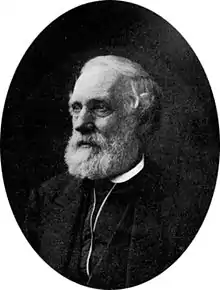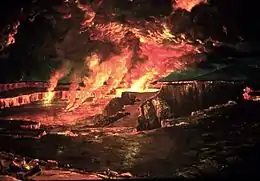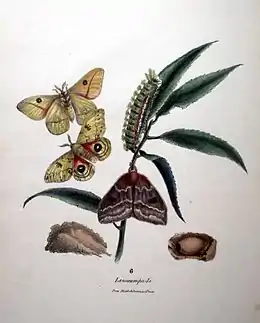Titian Peale
Titian Ramsay Peale (November 17, 1799 – March 13, 1885) was an American ornithologist, entomologist, photographer, and explorer from Philadelphia, Pennsylvania.[1] He was a scientific illustrator whose paintings and drawings of wildlife were (and are) known for their beauty and accuracy.[2][3]
Titian Ramsay Peale II | |
|---|---|
 | |
| Born | November 2, 1799 |
| Died | March 13, 1885 (aged 85) |
| Nationality | American |
| Education | Charles Willson Peale Thomas Say |
| Known for | Drawing and Watercolor Ornithology Entomology Natural history Photography |
Notable work | American Philosophical Society |
Peale was a member of several high-profile scientific expeditions. In 1819–1820, he and Thomas Say accompanied Stephen Harriman Long on an expedition to the Rocky Mountains.[4] He was also a member of the United States Exploring Expedition (1838–1842).[5] Peale is also known for his contributions to photography during his last decades.[6]
Peale was one of the first naturalists to expose the scientific fraud of John James Audubon.[7]
Biography


Family and early life
Peale was born in Philosophical Hall, Philadelphia, on November 17, 1799.[3] The youngest son of the polymath Charles Willson Peale and his wife Elizabeth de Peyster, Peale was named after his dead half-brother, also named Titian Ramsay Peale (1780–1798).[8] The family moved to Germantown, Pennsylvania, outside of Philadelphia, where Peale began collecting and drawing butterflies and other insects. Some of his drawings were published in Thomas Say's American Entomology as early as 1816, but most remained unpublished until recently.[9] Like his older brothers Raphaelle, Rembrandt, and Rubens Peale, Titian helped his father in the preservation of the museum's specimens for display.
Scientific career and expeditions
Peale was a member of the "first private, museum sponsored exploration in the United States", when he joined William Maclure, Thomas Say, and George Ord on an expedition to Florida and Georgia in 1817, sponsored by the Academy of Natural Sciences of Philadelphia (ANSP).[10][11]
In 1819–20, he and Say joined a government-led expedition to the Rocky Mountains led by Stephen Harriman Long, during which Peale made a large collection of drawings of natural objects and scenery.[12][13]

In the winter of 1824–25, Peale traveled to South Carolina and Florida to collect bird specimens for Charles Lucien Bonaparte's forthcoming quasi-continuation of Alexander Wilson's American Ornithology (1825–1833). In Florida, he boarded for a short time at the farm of Bonaparte's cousin, Achille Murat, and returned to Philadelphia in April 1825.[14]
In 1831–32, Peale explored the Magdalena River valley in northern Colombia. According to a notice published by Constantine S. Rafinesque in 1832: "Mr. Peale is just returned from his voyage to South America, and travels in 1831 up the R. Magdalena to Bogota. He has brought a fine zoological collection for the Philadelphia Museum, among which are 500 birds and 50 quadrupeds, which were not there. It is expected that he will publish an account of his zoological travels and discoveries. He asserts the very singular fact that the R. Magdalena has no shells and but few fishes."[15]
From 1833–1836, Peale managed the Philadelphia Museum which had been founded by his father Charles Willson Peale.[16]
In 1838, Peale boarded the Peacock and served as chief naturalist for the United States Exploring Expedition (1838–1842) led by Lt. Charles Wilkes.[17] The other naturalists on the expedition were James Dwight Dana and Charles Pickering. As chief naturalist, he collected and preserved various specimens of natural history, many of which he packed and shipped back to Philadelphia. During the expedition, Wilkes named Peale Passage after Titian Peale.[18][19]
In 1848, he was removed from the payroll of the scientific corps.[1] In 1851, a fire at the Library of Congress destroyed nearly all of the 100 copies of Peale's expedition report, Mammalia and Ornithology (1848), and its publication was delayed. John Cassin was hired to produce a corrected volume, which was published in 1858.
Scientific collections
Peale was the second ornithologist known to collect a female Golden-winged Warbler (Vermivora chrysoptera), and the first to illustrate it. Thomas Jefferson collected one in 1782.[20] Peale shot his specimen in 1824 near Camden, New Jersey, and his drawing was engraved by Alexander Lawson and published in Plate 1 of Bonaparte’s American Ornithology; or, the Natural History of Birds Inhabiting the United States, Not Given by Wilson, vol. 1 (Philadelphia: Carey, Lea & Carey, 1825).[21]
Peale developed an effective method for storing butterflies in sealed cases with glass fronts and backs, and parts of his collection of over 100 species still survive.[22]
Death and burial
He died on March 13, 1885 in Philadelphia and was interred at Laurel Hill Cemetery, Section 8, Lot 74, in an unmarked grave.[23]
Public collections and legacy

- Amon Carter Museum, Fort Worth, Texas
- Detroit Institute of Arts, Michigan
- Honolulu Museum of Art, Hawaii
- Joslyn Art Museum, Omaha, Nebraska
- Museum of Nebraska Art, University of Nebraska
- National Museum of American History, Photographic History Collection
- National Portrait Gallery, Washington, D.C.
- National Agricultural Library, Beltsville, MD, holds Peale's original manuscript, Drawings of American Insects; Showing Them in Their Several States, Together With Such Minute Insects as Require Investigation by Microscope.[24]
- Pennsylvania Academy of the Fine Arts, Philadelphia
- American Philosophical Society, Philadelphia
- Reading Public Museum, Reading, Pennsylvania
- Westmoreland Museum of American Art, Greensburg, Pennsylvania
- Yale University Art Gallery, New Haven, Connecticut, holds five of Peale's sketchbooks from the Stephen H. Long Expedition
- Academy of Natural Sciences, Philadelphia, holds Peale's butterfly and moth collections
- Carnegie Museum of Natural History, Pittsburgh, holds additional specimens collected by Peale
- American Museum of Natural History, New York City, holds Titian Ramsey Peale's unpublished manuscript of The Butterflies of North America
- Peale designed the reverse of the Gobrecht dollar minted from 1836 to 1839 and recycled for obverse of the Flying Eagle cent of 1856–1858.
- In 1923, Peale Island, one of the three islands surrounding the lagoon at Wake Atoll was named for Peale by Alexander Wetmore, lead scientist of the Tanager Expedition.
- In 1873 Robert Ridgway named the biggest subspecies of the peregrine falcons, the Peale's falcon, after him.
Notes
- Porter, Charlotte M. (1985). "The Lifework of Titian Ramsay Peale". Proceedings of the American Philosophical Society. 129 (3): 300–312. ISSN 0003-049X. JSTOR 987013.
- Peale, Titian Ramsay. "Titian Ramsay Peale Sketches". search.amphilsoc.org. Retrieved August 28, 2020.
- Murphy, Robert Cushman (1957). "The Sketches of Titian Ramsay Peale (1799-1885)". Proceedings of the American Philosophical Society. 101 (6): 523–531. ISSN 0003-049X. JSTOR 985520.
- James, Edwin; Long, Stephen Harriman; Say, Thomas; Adams, John (1823). Account of an expedition from Pittsburgh to the Rocky Mountains, performed in the years 1819 and '20 : by order of the Hon. J.C. Calhoun, sec'y of war: under the command of Major Stephen H. Long. From the notes of Major Long, Mr. T. Say, and other gentlemen of the exploring party /. Philadelphia: H.C. Carey and I. Lea ...
- Expedition, United States Exploring; Dougal, William H.; Stuart, Fred D.; Wilkes, Charles; Congress, Library of; Congress, U. S.; States, United; States, United (1844). United States Exploring Expedition. During the year 1838, 1839, 1840, 1841, 1842. Philadelphia: Printed by C. Sherman.
- Haifley, Julie Link (1980). "Capital Images: The Photography of Titian Ramsay Peale, 1855-1885". Records of the Columbia Historical Society, Washington, D.C. 50: 229–244. ISSN 0897-9049. JSTOR 40067819.
- Halley, Matthew R. (June 2020). "Audubon's Bird of Washington: unravelling the fraud that launched The birds of America". Bulletin of the British Ornithologists' Club. 140 (2): 110–141. doi:10.25226/bboc.v140i2.2020.a3. ISSN 0007-1595. S2CID 219970340.
- "Selected Papers of Charles Willson Peale and His Family | Yale University Press". yalebooks.yale.edu. Retrieved August 28, 2020.
- Calhoun (2016)
- American Philosophical Society Library, Philadelphia, PA. "George Ord Collection (Mss.B.Or2)".
- Say, Thomas (1901). "Letters of Thomas Say to John F. Melsheimer, 1816–1825". Entomological News, and Proceedings of the Entomological Section of the Academy of Natural Sciences of Philadelphia. 12: 233–236.
- Titian R. Peale, American Philosophical Society Library. "Titian Ramsay Peale Sketches (Mss.B.P31.15d)".
- Looking Close and Seeing Far: Samuel Seymour, Titian Ramsay Peale, and the Art of the Long Expedition, 1818Ð1823. Penn State Press. ISBN 978-0-271-04782-9.
- Stroud, Patricia Tyson (2000). The Emperor of Nature: Charles-Lucien Bonaparte and His World. Philadelphia, Pennsylvania: University of Pennsylvania Press. ISBN 978-0812235463.
- Rafinesque (Editor), Constantine S. (1832). "Scientific explorers in America and Africa". Atlantic Journal and Friend of Knowledge. In Eight Numbers. Containing About 160 Original Articles and Tracts on Natural and Historical Sciences, the Description of About 150 New Plants, and 100 New Animals or Fossils. Many Vocabularies of Languages, Historical and Geological Facts, &c. 1: 26.CS1 maint: extra text: authors list (link)
- Sellers, Charles Coleman (1980). Mr. Peale's Museum: Charles Willson Peale and the First Popular Museum of Natural Science and Art. W. W. Norton & Company. ISBN 978-0-393-05700-3.
- Adler, A. (May 1, 2011). "From the Pacific to the Patent Office: The US Exploring Expedition and the origins of America's first national museum". Journal of the History of Collections. 23 (1): 49–74. doi:10.1093/jhc/fhq002. ISSN 0954-6650.
- "Florida Naturalists – Titian Ramsay Peale – Introduction". www.floridamuseum.ufl.edu. Retrieved June 26, 2019.
- Phillips, James W. (1971). Washington State Place Names. University of Washington Press. ISBN 0-295-95158-3.
- Halley, Matthew R. (2018). "Jefferson's Ornithology Reconsidered" (PDF). Proceedings of the American Philosophical Society. 162: 231–258.
- Bonaparte, Charles Lucian; Wilson, Alexander; Audubon, John James; Rider, Alexander; Peale, Titian R.; Lawson, Alexander (1825). American ornithology; or, The natural history of birds inhabiting the United States, not given by Wilson. v.1 (1825). Philadelphia: Carey, Lea & Carey.
- Foutch, Ellery E. (2018). "Preserving the Perfect State: Titian Peale's Butterflies". Victorian Studies. 60 (2): 171–184. doi:10.2979/victorianstudies.60.2.03. ISSN 0042-5222. JSTOR 10.2979/victorianstudies.60.2.03. S2CID 149633005.
- "Titian Ramsey Peale". www.findagrave.com. Retrieved July 10, 2020.
- Library, National Agricultural. "National Agricultural Library – Home Page". www.nal.usda.gov. Retrieved June 26, 2019.
Published Works
Peale, T. R. 1831. Circular of the Philadelphia Museum: Containing Direction for the Preservation and Preparation of Objects of Natural History.
References
- Calhoun, J. V., & D. M. Wright (2016). "Remarks on the recent publication of Titian R. Peale's "lost manuscript," including new information about Peale's Lepidoptera illustrations". Journal of Research on the Lepidoptera. 49: 21–51.
- Poesch, Jessie Peale (1961). Titian Ramsay Peale And His Journals of The Wilkes Expedition, 1799–1885. American Philosophical Society. p. 226. ISBN 9781258056551.
- Sellers, Charles Coleman (1980). Mr. Peale's Museum, Charles Willson Peale and the First Popular Museum of Natural Science and Art. W. W. Norton & Company. pp. 370. ISBN 9780393057003.
- Sterling, Keir B., ed. (1997). "Peale, Titian Ramsay". Biographical Dictionary of American and Canadian Naturalists and Environmentalists. Greenwood Press.
- "Titian Ramsay Peale Sketches". American Philosophical Society.
External links
| Wikimedia Commons has media related to Titian Peale. |
- The Historic Titian Peale Butterfly and Moth Collection at the Academy of Natural Sciences
- Collection of Titian Ramsay Peale sketches at the American Philosophical Society Library.
- Scientist of the Day-Titian Ramsay Peale at Linda Hall Library
